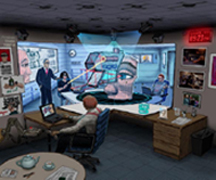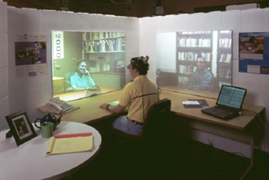|
The
Challenge |
|||
 |
 |
||
|
Sketch by Andrei State
|
3D tele-immersion testbed, Summer 2000
|
||
|
The Approach There are several specific sub-projects under the umbrella of the Office of the Future. Our Tele-Immersion work (a collaboration with the University of Pennsylvania) involves data acquisition of a distant office using a miniature “sea” of seven cameras; modeling of that data; tracking of the local user’s eye positions, using UNC-developed HiBallTM Wide-Area tracking technology; rendering the dynamic model of the remote scene based on the tracked user’s positions; and a stereo presentation to display a remote collaborator, all dynamically in real-time. The approach aims to make distant collaborators feel as if they were in an adjoining room, and could see each other through a large “window” in the connecting wall. Our PixelFlex team is developing an automatically reconfigurable, wide-area, high-resolution display wall. Eight projectors, each with computer-controlled pan, tilt, and zoom adjustments, seamlessly display one image that is geometrically and photometrically correct. We will eventually incorporate this into the Office of the Future, to vastly increase the amount of the “adjoining room” that can be seen. Our "Being There" team is exploring a new projector-based approach to visualizing re-creations of real or imagined places. Rather than using a planar display wall, we use display surfaces that closely approximate the virtual scene geometry in size and shape. The effect is a virtual environment that is both visually and spatially realistic, providing the user with a strong sense of immersion. We envision museum spaces with re-creations of famous places such as Monticello, President Thomas Jefferson’s home. Finally, our "Electronic Books" team (in collaboration with researchers at Brown University) is exploring the use of 3D capture and display to help train trauma surgeons. The idea is to create life-sized, high-fidelity, three-dimensional, dynamic, and annotated graphical reconstructions of surgery related to rare, but often fatal, trauma events. telecollaboration; tele-immersion; spatially-immersive displays; image-based modeling. |
|||